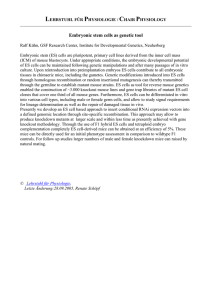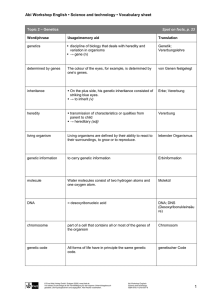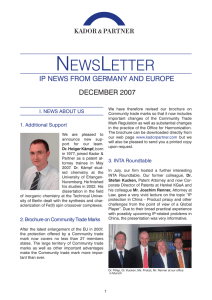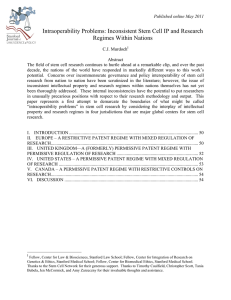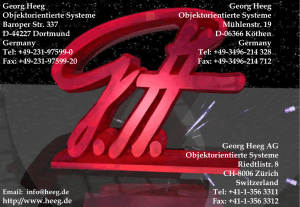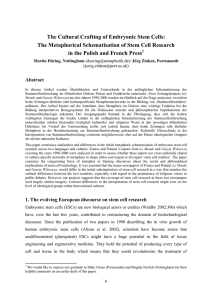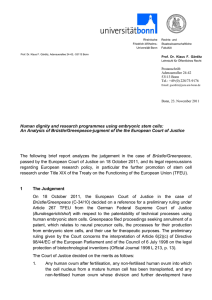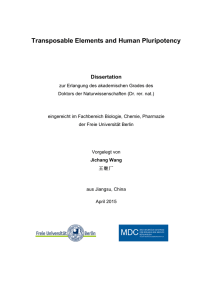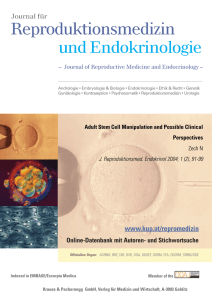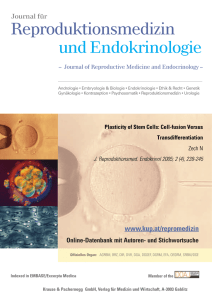26.11.2014 1 Haploide mESCs
Werbung
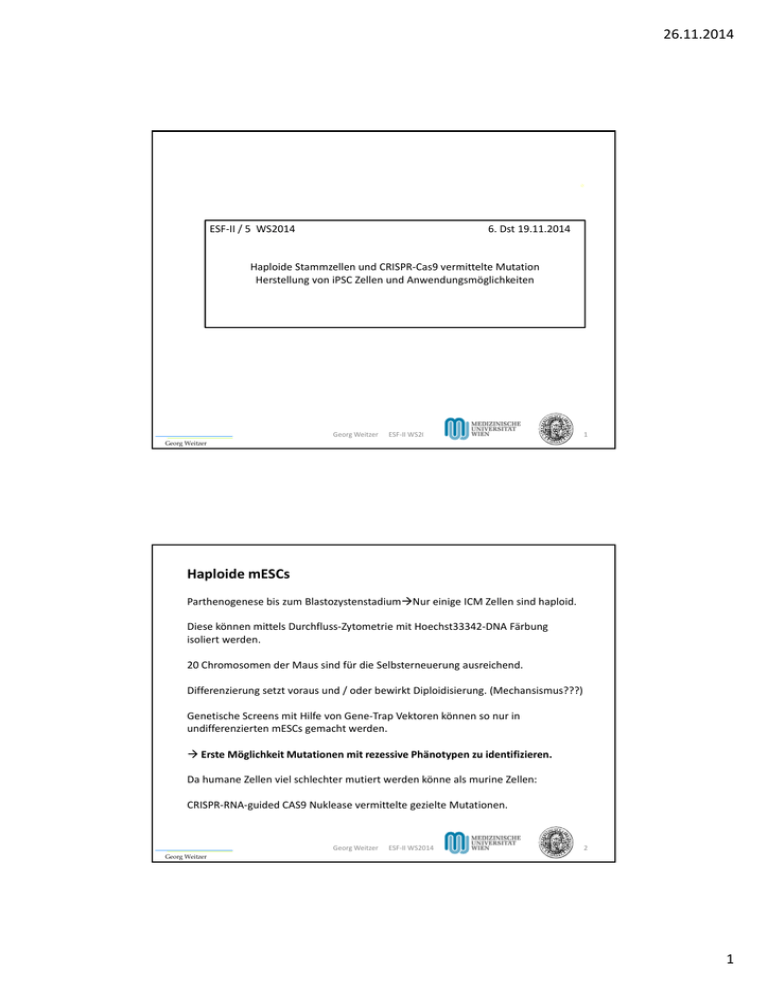
26.11.2014 ESF‐II / 5 WS2014 6. Dst 19.11.2014 Haploide Stammzellen und CRISPR‐Cas9 vermittelte Mutation Herstellung von iPSC Zellen und Anwendungsmöglichkeiten Georg Weitzer ESF‐II WS2014 1 Georg Weitzer Haploide mESCs Parthenogenese bis zum BlastozystenstadiumNur einige ICM Zellen sind haploid. Diese können mittels Durchfluss‐Zytometrie mit Hoechst33342‐DNA Färbung isoliert werden. 20 Chromosomen der Maus sind für die Selbsterneuerung ausreichend. Differenzierung setzt voraus und / oder bewirkt Diploidisierung. (Mechansismus???) Genetische Screens mit Hilfe von Gene‐Trap Vektoren können so nur in undifferenzierten mESCs gemacht werden. Erste Möglichkeit Mutationen mit rezessive Phänotypen zu identifizieren. Erste Möglichkeit Mutationen mit rezessive Phänotypen zu identifizieren. Da humane Zellen viel schlechter mutiert werden könne als murine Zellen: CRISPR‐RNA‐guided CAS9 Nuklease vermittelte gezielte Mutationen. Georg Weitzer ESF‐II WS2014 2 Georg Weitzer 1 26.11.2014 Haploide mESCs durch parthenogenetische Aktivierung von Oozyten Leeb &Wutz bzw. Elling …. & Penninger 2011 G1 G2 Sortierte Zellen G1 G2 Differenzierung 2n mESCs 1+2n m ESCs 1n ESCs Georg Weitzer ESF‐II WS2014 3 Georg Weitzer Cell Cycle. 2013 Jan 15;12(2):302‐11. doi: 10.4161/cc.23103. Epub 2012 Jan 15. Diploid, but not haploid, human embryonic stem cells can be derived from microsurgically repaired tripronuclear human zygotes. Fan Y1, Li R, Huang J, Yu Y, Qiao J. Abstract Human embryonic stem cells have shown tremendous potential in regenerative medicine, and the recent progress in haploid embryonic stem cells provides new insights for future applications of embryonic stem cells. Disruption of normal fertilized embryos remains controversial; thus the development of a new source for human embryonic stem normal fertilized embryos remains controversial; thus, the development of a new source for human embryonic stem cells is important for their usefulness. Here, we investigated the feasibility of haploid and diploid embryo reconstruction and embryonic stem cell derivation using microsurgically repaired tripronuclear human zygotes. Diploid and haploid zygotes were successfully reconstructed, but a large proportion of them still had a tripolar spindle assembly. The reconstructed embryos developed to the blastocyst stage, although the loss of chromosomes was observed in these zygotes. Finally, triploid and diploid human embryonic stem cells were derived from tripronuclear and reconstructed zygotes (from which only one pronucleus was removed), but haploid human embryonic stem cells were not successfully derived from the reconstructed zygotes when two pronuclei were removed. Both triploid and diploid human embryonic stem cells showed the general characteristics of human embryonic stem cells. These results indicate that the lower embryo quality resulting from abnormal spindle assembly contributed to the failure of the haploid embryonic stem cell derivation. However, the successful derivation of di l id diploid embryonic stem cells demonstrated that microsurgical tripronuclear b i t ll d t t d th t i i lt i l zygotes are an alternative source of t lt ti f human embryonic stem cells. In the future, improving spindle assembly will facilitate the application of triploid zygotes to the field of haploid embryonic stem cells. Georg Weitzer ESF‐II WS2014 4 2 26.11.2014 Aus: Cell Cycle 12:2, 302–311; January 15, 2013; © 2013 Landes Bioscience Figure 1. Effects of PN removal on the quality of reconstructed eight‐cell embryos and the representative image of embryos in 3PN, r2PN and r1PN groups. (A) The quality of embryos at the eight‐cell stage tended to decrease with the increasing number of removed PN. The ratio of high‐quality embryos was (B) significantly decreased in the r1PN group. Means with “a” or “b” are significantly different (p < 0.05). (B) No significant morphological differences (C) were observed among the three groups before blastocyst formation; however, no high‐quality blastocysts were formed in the r1PN group. Georg Weitzer ESF‐II WS2014 5 Gezieltes Einführen von Mutationen in ein Genom wenn Mutagenese durch Homologe Recombination nicht möglich ist. CRISPR /CAS9 CRISPR = Clustered Regularly Interspaced Short Palindromic Repeats CAS9 = CRISPR‐associated protein 9 Aus Georg Weitzer ESF‐II WS2014 6 Georg Weitzer 3 26.11.2014 Aus Georg Weitzer ESF‐II WS2014 7 Georg Weitzer Induzierte pluripotente Stammzellen (iPSCs) Herstellung, Eigenschaften und A Anwendungsmöglichkeiten d ö li hk it Georg Weitzer ESF‐II WS2014 8 4 26.11.2014 Herstellung von iPSCs • Lentivirale polycistronische OKSM Vektoren • FBx15::EFGP Reporter‐Fibroblasten O…Oct4 K…Klf4 S…Sox2 M M M…c‐Myc • BAC: Nanog::GFP/PuroR/Nanog Reporter‐Fibroblasten Nanog Expression erlaubt iPSC Mäuse herzustellen. N…Nanog L…Lin28 • Lentivirale OSNL Vektoren • Reprogrammieren nur mit Proteinen, RNA, kleinen synthetischen Molekülen. RepSox; STAP‐Zellen, Mycobacterium laprae induzierte Reprogrammierung ……alles sehr ineffizient! Georg Weitzer ESF‐II WS2014 9 Herstellung von iPSCs Aus Genes Dev. Oct 15, 2010; 24(20): 2239–2263. Models of cellular reprogramming. (A) Mature cells, such as lymphocytes, reprogram into iPSCs at lower efficiencies than immature cells such as efficiencies than immature cells, such as hematopoietic stem cells. This may be due to a lower number of stochastic epigenetic events (represented by circled numbers and arrows) that are required in immature cells to acquire pluripotency. The precise number and nature of such changes is unclear (represented by “n”). (B) Scheme summarizing major changes that characterize the transition of somatic cells into iPSCs. The early steps are reversible, as indicated by the dashed reverse arrows. “Immature iPSCs” are defined as cells that have already acquired pluripotency but still retain an epigenetic memory of their cell type of origin, while “mature iPSCs” have lost this memory. The wavelines below indicate assumed reprogramming roadblocks that cells are facing at different stages. Failure to pass any of these roadblocks may result in cells that arrest at that stage or, alternatively, undergo senescence or apoptosis. Georg Weitzer ESF‐II WS2014 10 5 26.11.2014 Putative role of reprogramming factors during iPSC formation. (A) Scheme depicting the expression of exogenous (red circles) and endogenous (dark‐ green circles) pluripotency factors at the protein level during different stages of reprogramming. The reprogramming process is initiated predominantly by the exogenous factors, which are gradually replaced by endogenous proteins as well as their targets, such as Nanog (N) or as‐yet‐unidentified factors (X) (light‐green factors (X) (light green circles). The endogenous loci circles). The endogenous loci of some reprogramming factors (such as c‐Myc, Klf4, and Sox2) are expressed in some somatic cell types, and the corresponding endogenous proteins might thus become available before activation of the Oct4 locus. (B) Scheme illustrating how the reprogramming factors may exert the rapid repression of somatic genes and the gradual activation of pluripotency (ESC) genes, two processes assumed to be mediated largely by Klf4, Sox2, and Oct4. Somatic gene silencing is associated by single‐factor binding to promoter regions, while ESC gene activation involves the establishment of multi‐protein complexes. The initial loss of repressive marks (such as DNA methylation and H3K27 histone trimethylation) at ESC promoters might be a passive process driven by multiple rounds of cell division. (C) Scheme showing activation of genes promoting cell division (such as cyclins) by c‐Myc and repression of the Ink4a/Arf tumor suppressor locus conferring immortality by an as‐yet‐undefined combination of reprogramming factors. Aus Genes Dev. Oct 15, 2010; 24(20): 2239–2263. Georg Weitzer ESF‐II WS2014 Vektoren für die Reprogrammierung Zellarten 11 Stand 2011 E2A selbst‐spaltenden Protease Aus Adenoviridae Von Biosettia Georg Weitzer ESF‐II WS2014 12 6 26.11.2014 iPSC ‐ Probleme • Effizienz • Reprogrammierung nicht vollständig • Reprogrammierung nicht stabil Epigenetisches Gedächtnis der iPSCs • Tumorbildung c‐Myc, Lentivirus Reaktivierung, Reaktivierung der Transgene, … Georg Weitzer ESF‐II WS2014 13 Nat Rev Genet. 2013 Jun;14(6):427‐39. doi: 10.1038/nrg3473. Mechanisms and models of somatic cell reprogramming. Buganim Y1, Faddah DA, Jaenisch R. Phases of the reprogramming processI In the model we discuss in this review the reprogramming process can broadly be divided into two phases: firstly a long `stochastic' In the model we discuss in this review, the reprogramming process can broadly be divided into two phases: firstly, a long stochastic phase of gene activation; and phase of gene activation; and secondly, a shorter hierarchical more `deterministic' phase of gene activation that begins with the activation of the Sox2 locus. After a fibroblast is induced with OSKM, it will initiate stochastic gene expression and assume one of several possible fates (such as, apoptosis, senescence, transformation, transdifferentiation or reprogramming). In the early phase, reprogrammable cells will increase proliferation, undergo changes in histone modifications at somatic genes, initiate mesenchymal to epithelial transition, and activate DNA repair and RNA processing. Then the reprogrammable cells will enter an intermediate phase with an unknown rate‐limiting step that delays the conversion to iPSCs and contributes to the long latency of the process. In this phase, cells undergo a stochastic activation of pluripotency markers23, a transient activation of developmental regulators17, and activation of glycolysis18. In general the transcriptional changes in this phase are small. In some rare cases, the stochastic gene expression will lead to the activation of "predictive markers" such as Utf1, Esrrb, Dppa2, and Lin28, which then will instigate the second phase that starts with the activation of Sox2. Activation of Sox2 by the “predictive markers” can be direct or indirect and will trigger a series of deterministic events that will lead to an iPSC. In this late phase, the cells eventually stabilize into the pluripotent state in which the transgenes are silenced, the cytoskeleton is remodeled to an ESC‐like state, the epigenome is reset and the core pluripotency circuitry is activated16–18,23. In this model, probabilistic events decrease and hierarchical events increase as the cell progresses from a fibroblast to an iPSC. Georg Weitzer ESF‐II WS2014 14 7 26.11.2014 iPSC‐Anwendungsmöglichkeiten • Herstellung von patientenspezifischen iPSCs Erforschung von Ursachen und Therapiemöglichkeiten von Krankheiten polygenetischen Ursprungs. • Verwendung dieser Zellen zum Auffinden neuer Krankheits‐ oder Patienten‐spezifischer Medikamente. • Entwicklung von alternative Strategien zur direkten programmierten Transdifferenzierung von einem somatischen Zelltyp in einem anderen. z.b. Herzzellen und Leberzellen aus Fibroblasten Georg Weitzer ESF‐II WS2014 15 Potential applications of iPSCs. Shown are the potential applications of iPSC technology for cell therapy and disease modeling using SMA as an example. In SMA patients, motor neurons are afflicted and die, causing the devastating symptoms of the disease. SMA‐specific iPSCs could be coaxed into motor neurons in vitro in order to establish a culture model of the disease that may lead to the identification of novel drugs that prevent the abnormal death of motor neurons in patients. Alternatively, if known, the disease‐causing mutation could be repaired (in this case the SMA gene) in iPSCs by gene targeting prior to their differentiation into healthy motor neurons, followed by transplantation into the patient's brain. Aus Genes Dev. Oct 15, 2010; 24(20): 2239–2263. Georg Weitzer ESF‐II WS2014 SMA = spinale Muskelatrophie 16 8 26.11.2014 Human: GMT + Mesp1 + EsrrG + FOG2 + Myocardin Mouse: GATA4+Mef2C+Tbx5 Direkte programmierte Transdifferenzierung Fibroblast Herzzelle OKSM‐vermittelte Reprogrammierung Konventionelle Differenzierungg iPSC Georg Weitzer ESF‐II WS2014 17 Georg Weitzer Weiterführende Literatur: Siehe • Shinya Yamanaka • Marius Wernig • Konrad Hochedlinger • Rudolf Jänisch Georg Weitzer ESF‐II WS2014 18 9
